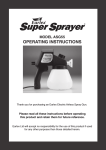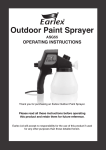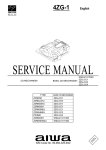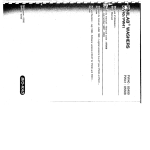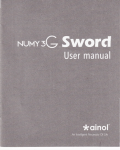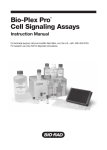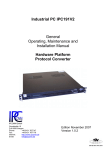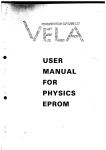Download Earlex ASG100 Operating instructions
Transcript
MODELS: ASG100, ASG120 OPERATING INSTRUCTIONS Thank you for purchasing an Earlex Electric Airless Spray Gun, this is a highly versatile spray gun and can be used for a variety of applications. Please read all these instructions before operating this product and retain them for future reference. Earlex Ltd will accept no responsibility for the use of this product if used for any other purposes than those detailed herein. SECTION (1) (2) (3) (4) (5) (6) (7) (8) (9) (10) (11) CONTENTS PAGE TITLE Safety Operating Instructions What is included with your Spray Gun? About the Spray Gun Parts and Accessories list PAGE NO Page. 3 Page. 4 Page. 5 Page. 6 Preparation Page. 7 Thinning Preparing and using your Spray Gun Page. 7 Page. 8 Remote Pick-up system (ASG120) Page. 10 Troubleshooting Page. 14 General Cleaning Instructions Mains Connection Page. 11 Page. 15 2 (1)SAFETY OPERATING INSTRUCTIONS WARNING: When using the spraygun, basic safety precautions, including the following, should always be followed to reduce the risk of fire, electric shock and personal injury. ● Keep work area clean - Cluttered areas and benches ● Always keep the spray nozzle in place during invite injuries. use. Never allow the spray nozzle to come in direct contact with the skin. ● Consider work area environment - Do not expose the ● Always ensure there is adequate ventilation when spray gun to rain. Do not use the spray gun in damp or wet locations. Keep work area well lit. spraying. ● Guard against electric shock - Avoid body contact with ● Never spray near a source of ignition, e.g. hot earthed or grounded surfaces (e.g. pipes, radiators, ranges, refrigerators). surfaces, sparks, cigarettes, glowing wires & open flames including appliance pilot flame. ● Keep children away away from the spray gun. ● The spray gun must not be used for spraying flammable materials below flashpoint 21˚C. ● When not in use, spray gun should be stored in a dry, high or locked place, out of reach of children. ● Always beware of any hazards presented by the material being sprayed and consult the markings on the container or the information supplied by the manufacturer of the material to be sprayed, including requirements for the use of personal protective equipment. Do not spray any material where the hazard is not known. ● Use the spray gun for the job it was designed for only. Mis-use of the spray gun will invalidate the guarantee. ● Dress properly - do not wear loose clothing or jewellery, they can be caught in moving parts. Rubber gloves and non-skid footwear are recommended when working outdoors. Wear protective hair covering to ● The spray gun must not be cleaned with flammable contain long hair. liquids below flash point 21˚C. ● Always wear a mask when spraying. ● Check for damaged parts - Before further use of the spray gun, a guard or other part that is damaged should be carefully checked to determine that it will operate properly and perform its intended function. Check for alignment of moving parts, free running of moving parts, breakage of parts, mounting and any other conditions that may affect its operation. A guard or other part that is damaged should be properly repaired or replaced by an authorized service centre unless otherwise indicated in this instruction manual. Have defective switches replaced by an authorized service facility. Do not use the tool if the switch does not turn it on and off. ● We recommend the use of eye protection to keep hazardous vapours out of eyes. ● We recommend the use of ear protectors. ● Do not abuse the cord - Never carry the tool by the cord or pull it to disconnect it from the socket. Keep the cord away from heat, oil and sharp edges. ● Do not overreach - Keep proper footing and balance at all times. ● Always disconnect from mains supply when not in ● Warning - The use of any accessory or attatchment, ● Avoid unintentional starting, do not carry a plugged in ● Maintain tools with care - Follow instructions for use, when refilling the paint container and before cleaning. other than those recommended in this instruction manual, may present a risk of personal injury. tool with a finger on the switch and ensure the switch is off when plugging in. lubrication and changing the accessories, inspect tool regularly and if damaged, get repaired by an authorized service centre. ● When tool is used outdoors, use extension cords only intended for outdoor use. ● Have your tool repaired by a qualified person – This electric tool is in accordance with the relevant safety requirements. Repairs should only be carried out by qualified persons using original spare parts, otherwise this may result in considerable danger to the user. ● It is recommended that a RCD (residual current device) rated at 30mA is fitted into the mains supply socket for added protection against electric shock. ● Stay alert - Watch what you are doing. Use common ● Use genuine Earlex parts only. sense and do not operate tool when you are tired. ● Never under any circumstances aim the nozzle at another person or animal. In the event of injury occuring seek expert medical advice immediately. NOISE AND VIBRATION LEVELS The following values were measured in accordance with EN50144. Continuous A-weighted equivalent sound pressure level: 90 dB(A). A-weighted sound power level: 103 dB(A) Vibration level: 12 m/s2 3 (2)WHAT IS INCLUDED WITH YOUR SPRAY GUN ASG100 & ASG120 kits include: ● ● ● ● Spray gun with 1.0mm spray nozzle (yellow) fitted, for spraying woodcare treatments. ● Flexible Extension (with Swirl head), can be bent up to 45˚, to paint horizontal or angled surfaces. ● Replacement atomiser valve. Atomiser valves wear with use. See ‘Maintenance and Repair’. (See section 9) ● Viscosity cup, which enables you to test a paints suitability for spraying. 0.6mm general purpose spray nozzle (black). Bottle of Lubricating Oil Piston Punch, to help free the piston in the unlikely event of a seizure. ASG120 kits also include: ● ● Remote Pick Up system. For larger jobs, paint can be fed directly from a can. See section ‘Remote Pick Up system’. 0.8mm spray nozzle (blue) for spraying emulsion and other thick materials. SAFETY WARNING LABEL 10 20 30 40 50 60 70 80 90 One of the labels on the spray gun is a warning label and shows three diagrams. If you are in any doubt about their meaning, please see the explanation below. Do not direct the spray gun at yourself or anyone else. (Risk of injection) Do not use your spray gun in wet weather. 4 <21˚C Do not use your spray gun for spraying flammable materials. i.e those with a flashpoint less than 21˚C. (3)ABOUT THE SPRAY GUN TO OBTAIN THE BEST RESULTS FROM YOUR SPRAY GUN READ THESE INSTRUCTIONS CAREFULLY BEFORE USE. The Spray Gun is a highly versatile electric airless spray gun. It can be used to spray many different materials including varnishes, wood preservatives, enamel paints, oil based paints & water based paints. The spray gun can be used for a variety of applications including, fences, sheds, boats, furniture, radiators, models & louvre doors. Airless spraying reduces the mist associated with air spraying & reduces paint loss. PLEASE NOTE We have done all we can to ensure that used correctly and according to these instructions, the Earlex Electric Airless Spray Gun will give long trouble free service. We accept no responsibility for damage caused by the use of incorrect or unsuitable substances, paint or fluids which have not been thinned correctly or are unsuitable for the surfaces to which they are applied, health hazards arising from lack of ventilation when working in confined spaces, or failure of the equipment due to inadequate cleaning of components after use. If in doubt, always test a small inconspicuous area first. Always read the paint manufacturers instructions first. Neither our guarantee nor the above statement affect your statutory rights. IMPORTANT - Selecting the Paint Many paints & other materials can be sprayed but some cannot. Always check the manufacturer’s recommendations before using products with your spray gun. THE SPRAY GUN MUST NOT BE USED FOR SPRAYING EXTERIOR TEXTURED WALL PAINTS OR TEXTURED COATINGS. USING THESE MATERIALS WILL CAUSE PREMATURE WEAR ON THE PISTON & WILL INVALIDATE YOUR GUARANTEE. IF YOU HAVE ANY PROBLEMS WITH YOUR SPRAY GUN OR IF YOU BELIEVE A PART IS MISSING, DO NOT RETURN TO STORE. PLEASE CONTACT EARLEX LTD ON 01483 454666. 5 6 15 5 3/4 14 17 1. ASG100 Main Gun Assembly (including mains lead) 2. ASG120 Main Gun Assembly (including mains lead) 3. Cylinder Housing (ASG100)* 4. Cylinder Housing (ASG120)* 5. Piston Spring* 6. Piston* 7. Locking Collar 8. Nozzle 1.0mm (yellow)* 9. Nozzle 0.6mm (black)* 11. Atomiser Valve* 12. Suction Tube & Filter* 13. Paint Container* 14. Flexible Extension 19 12 11 16 18 1/2 7 8/9 /10 20 13 15. 16. 17. 18. SG435 SG436 SG453 SG434 SG442 SG395 SG400 SG414 SG416 SG473 SG240 SG242 SG281 Swirl Head Viscosity Cup Lubricating Oil Piston Punch ASG120 only 10. Nozzle 0.8mm (blue)* 19. Clip for Tube 20. Remote Pick Up Tube * Circled numbers need to be cleaned after every use. 6 SG200 SG243 SG244 SG318 SG415 SG431 SG432 (5)PREPARATION Preparation of the surface and thinning of the paint are the two most important areas to be concerned with to obtain the best results from your spray gun. Ensure all surfaces are free from dust, dirt, rust and grease. If necessary rub down with sandpaper, or similar. Mask areas you do not wish to be painted. (6)THINNING Your spray gun is supplied with a viscosity cup. Viscosity is a technical term used to indicate if the paint is very thin or very thick. If thin, the viscosity is said to be low, while if very thick the viscosity is said to be high. Viscosity is measured in seconds. In order to spray some paints they need to be “thinned” (diluted). Thinning is very important when spraying. Most paints are supplied ready for brush application and may need to be thinned (diluted) for spraying purposes. Follow the manufacturers guide for thinning. If in doubt please contact the manufacturers of the paint. The viscosity cup supplied will help you determine the correct thickness of the paint. Paint is “thinned” by adding the substance which the paint is based upon. If water based paint then water is added, if oil based then white spirit, if automotive paint then an automotive paint thinner is added. As some paints, wood preservatives and other sprayable products contain particles. Please ensure that when filling the paint container of the spray gun, that the paint is filtered through either a funnel with a filter on it or through nylon tights or stockings. This will ensure that no large particles enter the paint container, so preventing blockages and providing you with trouble free spraying. Ensure that a facemask, gloves and goggles are worn at all times when spraying. Water based paints Oil Based paints Enamel paints Wood preservatives Primers Varnishes 35-45secs 15-25secs 15-25secs no dilution 20-30secs 20-25secs Aluminium paints Wood stains Latex Emulsions Smooth Masonry Paint (non grit) 15-25secs no dilution *10-20% dilution *5-10% dilution * These paints cannot be measured in the viscosity cup. To spray them, remove the filter from the suction tube, thin according to manufacturer’s recommendations and strain to remove any lumps or particles. This spray gun can be used with paints having a viscosity ranging from 15 to 45 seconds. Dip the viscosity cup into the material and fill up. Time how long it takes for the viscosity cup to empty (Fig.1). Using the above chart (or manufacturer’s instructions) as a guide, determine if the material requires further thinning, if so then thin accordingly. Important: Before you begin to thin the paint, ensure it is stirred thoroughly. Fig.1 If the paint requires thinning, start with a 10% dilution of the paint. To do this, half fill the paint container with the required paint. The viscosity cup supplied with the unit holds 1/10 of a litre, block the hole in the viscosity cup and fill up with the required thinner. Add the thinner to the paint and stir, measure the viscosity using the recommended viscosity chart above. If the paint requires further thinning, dilute the paint by another 5% (5% will be equal to half a viscosity cup) with the required thinner and measure the viscosity, if the paint is not at it's recommended viscosity, repeat the above step. Note: Some paints are outside the ranges listed above. Please contact our helpline for further information. 7 (7)PREPARING & USING YOUR SPRAY GUN SAFETY WARNING! DO NOT SPRAY FLAMMABLE MATERIALS (FLASH POINT < 21˚C). ALWAYS SPRAY IN A WELL VENTILATED AREA. NEVER SPRAY NEAR NAKED FLAMES. ALWAYS WEAR PROTECTIVE FACE MASK, GOGGLES, GLOVES & EAR PROTECTORS WHEN USING YOUR SPRAYGUN. MASK THE AREAS OF THE ITEM THAT YOU DO NOT WANT TO SPRAY & PROTECT ANY ADJACENT AREAS THAT COULD BE AFFECTED BY OVERSPRAY. Before fitting the paint container, turn the spray gun upside down & put a few Fig.2 drops of lubricating oil down the inlet and outlet spouts. (see Fig.2) Plug the spray gun into a power socket & run the motor for one or two seconds to distribute the oil around the cylinder & piston. Disconnect the power & push the Suction Tube & Filter firmly into the inlet spout, which is the longer of the two spouts. Fill the container with the prepared paint or other medium, which as a precaution should be filtered through a suitable funnel that has a filter. As an alternative to a filter the paint can be poured through a nylon stocking or tights. This should ensure there is no contamination of the paint that could block or damage the spray gun. DO NOT FILL THE CONTAINER BEYOND THE MAXIMUM LEVEL INDICATED. Screw the spray gun tightly onto the filled container. Plug the spray gun into a power socket and it is now ready to be set up. SETTING UP THE SPRAY GUN FOR OPTIMUM PERFORMANCE When setting up the spray gun we recommend that you spray the paint onto some scrap material, newspaper or cardboard. Purge the air from the spray gun by running it for a few seconds until the paint comes out of the MAXIMUM MINIMUM gun. The volume of paint & the spray pattern is controlled using the Output CONTROL KNOB Control Knob, (see fig. 3). Turn the knob anti-clockwise to increase the volume of paint sprayed & clockwise to decrease the amount of paint sprayed. A good spray pattern is achieved when there is an even amount of paint in a fine spray throughout the pattern. A poor spray pattern will concentrate the paint in the centre of the spray & give a blotchy finish. To get the best spray performance, turn the Output Control Knob fully anticlockwise. Aim the gun at a piece of cardboard, or similar waste material, Fig.3 & press the switch to start the spray gun. With the spray gun running, turn the Output Control Knob clockwise until the best spray pattern is achieved. If you are unable to achieve an even, fine spray you will probably need to thin the paint further. Follow the thinning procedure as described under “Preparing the Paint”. SPRAYING TECHNIQUE To obtain best results keep the spray gun level & square to the surface being sprayed. The gun works best if the nozzle is kept about 25 – 30 cms (10” – 12”) from the surface being sprayed. (See Fig. 4) This will result in consistent, even coverage. To avoid overlap of the paint & therefore uneven coverage, we recommend that the spray gun be momentarily turned off whenever you change direction. Move the spray gun at an even speed. A fast speed will give a thin coat & a slow speed will give a thicker coat. Never tilt the spray gun more than 45˚ as this could result in paint getting in to the motor & causing serious damage. 8 Fig.4 HELPFUL HINTS 1) Only apply one coat at a time. If more than one coat is required follow the paint manufacturers instructions for drying times. 2) If spraying small objects keep the output setting low as this will avoid excessive use of paint & will minimise overspray. 3) When spraying large areas or objects use a criss-cross pattern either left to right then up & down or vice-versa. Remember to momentarily stop spraying as you change direction. This will ensure maximum coverage. (See Fig. 5) 4) Avoid stopping and starting when spraying as this can lead to too much or not enough material on a surface. 5) To ensure edges are covered begin spraying just outside the area being sprayed & do not stop until you have just passed the opposite edge. Fig.5 SPRAY NOZZLE SELECTION The ASG100 spray gun is supplied with 0.6mm and 1.0mm nozzles, the ASG120 spray gun is also supplied with a 0.8mm nozzle, these should be used as follows: 1) 0.6mm - This size works best for oil-based materials, stains, sealers, lacquers, water-proofers and enamels for small application areas. 2) 0.8mm - This is a general purpose nozzle that works best for materials such as emulsions, latex and thicker type paints. 3) 1.0mm - This nozzle is suitable for spraying woodcare treatments. If when spraying you find that the spray pattern is small and splattery, and adjusting the output control knob does not solve the problem, try a different nozzle size before further thinning the material. USING THE FLEXIBLE EXTENSION TUBE. Using the Flexible Extension Tube makes the painting of ceilings, floors & all horizontal surfaces much easier. When fitted, the Flexible Extension Tube is bent to avoid tilting the spray gun. Tilting the spray gun excessively can cause paint to leak into the motor, causing serious damage. TO FIT THE FLEXIBLE EXTENSION TUBE (SEE FIG.6) 1) Unscrew the spray gun nozzle by turning it anti-clockwise. Be sure to leave the valve in place but check for wear. 2) Screw the end of the extension tube, with the internal thread, tightly onto the spray gun. Leaks may occur if the flexible extension is loose or if excessive force is used to fit it. e.g. NOZZLE using pliers. FLEXIBLE EXTENSION 3) Fit a swirl head into the end of the flexible extension tube with the external thread. 4) Screw a nozzle onto the end of the flexible extension tube. 5) Bend the flexible extension to the required angle (45˚ maximum). Do not bend the extention tube more times than necessary, as SWIRL HEAD repeated bending can cause premature failure. ATOMISER VALVE 9 Fig.6 (8)REMOTE PICK UP SYSTEM - (ASG120 only) For larger painting tasks, use the Remote Pick Up System. This enables you to draw paint directly out of a large can instead of using the paint container supplied with the spray gun, thereby saving considerable time and making painting an even easier job. When using the remote pick up system secure the Remote Pick Up Tube to the can using the Remote Pick Up Clip provided. If working from a ladder, the can may be carefully hung from a rung on the ladder using a wire hook. We recommend a maximum continuous spray time of 30 mins, with a minimum break of 20 mins before spraying again to avoid fatigue. ● ● ● ● ● ASSEMBLING THE REMOTE PICK UP SYSTEM (SEE FIG.7) Unscrew and remove the paint container and remove the Suction Tube and Filter from the inlet spout. If the spray gun is being used for the first time, lubricate the piston and cylinder before continuing. See ‘Preparing and Using your Spray Gun’ Push the remote Pick Up Tube (2) firmly over the two spouts of the cylinder moulding. Fit the Suction Tube and Filter (3) securely to the same side of the Pick Up Tube that is connected to the inlet spout of the cylinder moulding. Immerse the Suction Tube and Filter into the can of paint and secure the Pick Up Tube to the can using the Remote Pick Up Tube Clip (1). When using the spray gun with the remote pick up system, only use the gun in the normal upright position, to allow excess paint to drain away down the Pick Up Tube. PRIMING THE SPRAY GUN When using the remote pick up system you must remove all the air by priming the system as follows:- 1. Turn the output control knob fully anticlockwise to the maximum position. 2 3 1 Fig.7 2. Make sure the spray gun is plugged in. 3. Hold the spray gun below the level of paint to speed the priming. 4. Aim the spray gun at a piece of cardboard or old newspaper, squeeze the trigger and hold until all air is out of the system and paint is flowing freely from the nozzle. This should take about two minutes. WARNING- When using the Remote Pick Up system the filter, of the Suction Tube and Filter, must be completely submerged in the paint at all times. If not completely submerged, air will be sucked into the system and the piston may seize. If this happens, the sound of the gun will change to a low hum and it will quickly become hot. Stop using immediately. Allow the gun to cool, then clean and lubricate the gun throughly before re-using. - See cleaning instruction section on section .9. 10 (9)GENERAL CLEANING INSTRUCTIONS After every use it is essential that you clean the spray gun thoroughly This will prevent any blockages occuring and provide consistant performance when you next come to use it. The spray gun contains moving parts. If not cleaned correctly, paint will dry and stop these moving parts from working. When you have finished spraying, empty any remaining material out of the paint container and clean it thoroughly using the thinners required for the job. Rinse the spray gun container with the thinners required for the job and spray through the gun onto cardboard or newspaper, and follow the instructions below. Refer to spare parts section on page 6 when carrying out the below. ● ● ● Disconnect the spray gun from the mains power. Unscrew paint container (13) and pull out the suction tube (12). Unclip the filter from the suction tube (12). 11 ● ● ● ● ● ● Unscrew the spray nozzle (8,9 or 10) and remove the atomiser valve (11), making sure that the spring is not ‘stretched’ during removal. Unscrew the locking collar (7). Remove cylinder housing (3 or 4) from the motor housing, by pulling forward and down. Remove the piston (6) and spring (5). Submerge all of the components into a cleaning fluid compatible with the material being sprayed. Clean all parts thoroughly. 12 ● ● Lightly oil the piston (6) and slide in and out of the cylinder housing (3 or 4) to distribute the oil over the mating parts. Re-assembly is the reverse of the above. REMEMBER - DO NOT USE FLAMMABLE THINNERS (except white spirit & turpentine substitute) CLEANING THE REMOTE PICK UP COMPONENTS Run an appropriate thinners through the tube until it is clean. Disassemble the fittings at both ends before any remaining paint dries, and thoroughly clean the remote pick up tube, suction tube and filter. MAINTENANCE AND REPAIR Please be aware that certain parts of this spray gun will wear, requiring replacement and that these parts are not covered by guarantee. These parts include the valve, spray nozzle, piston and spring. The wear on these parts depends on the abrasiveness of the paints being sprayed. The more abrasive the paint, such as latex paint (emulsions) will cause these parts to wear much faster. You would normally expect to replace an atomiser valve after spraying between 25-45 litres of latex. A worn valve will cause a poor spray pattern and will require replacing. Replacement valves are available from the Earlex Service Department (see page 16 for contact details). You will need to check the spray nozzles, piston and spring from time to time to check for wear. Replace if necessary. NEVER DISPOSE OF PAINTS OR SOLVENTS INTO DRAINS. CONTACT YOUR LOCAL COUNCIL TO ARRANGE COLLECTION. 13 PROBLEM CAUSE Spray gun hums but does not operate Piston sticking No suction feed No valve in pump Spray Gun motor operates, but nothing comes out Spray Gun motor operates but spluttering Paint pick-up filter blocked Clean filter (12) Worn atomiser valve Replace atomiser valve (11) Nozzle or atomiser valve blocked Clean parts thoroughly see 'General Cleaning Instructions'. Worn nozzle Paint too thick Output control is incorrectly set Runs and sags in paint Insert atomiser valve (11) Thin paint as recommended. See 'Preparing the Paint'. Spray Gun Held at wrong angle Excessive overspray Remove the nozzle (8/9/10) and atomiser valve (11). Unscrew the locking collar (7) and remove the cylinder housing and piston assembly (3/4/5/6). Use the piston punch (18) provided in the spares pack to eject the piston. Clean and lubricate the piston and cylinder. Re-assemble carefully in reverse order. (See Cleaning Instructions on P.11). Paint too thick Container almost empty Paint dripping from nozzle ACTION REQUIRED Nozzle loose Replace nozzle (8/9/10) Refill container (13) Hold at correct angle see 'Spraying Technique' Thin paint as recommended see 'Preparing the Paint' Adjust output control knob see 'Setting up Spray Gun for optimum Performance' Tighten nozzle (8/9/10) Spray Gun held at more than 45˚ Hold at correct angle see 'Spraying Technique' Holding spray gun too far from surface Hold spray gun about 30cm (12") from workpiece. (See Spraying Techniques on P.7) Pressure too high Arm movement too slow Spray Gun too close to work surface Applying too much paint in one go 14 Use larger diameter nozzle See 'Spraying Techniques' and 'Helpful Hints’ on P.7 & 8) Output control is incorrectly set. (11)MAINS CONNECTION (WARNING-THIS APPLIANCE MUST BE EARTHED) Your unit will have been supplied with a mains lead with a fitted moulded plug. This is identified by the fuse holder in the base of the plug. Please read the following safety instructions before use. 1. If the moulded plug is cut off from the mains lead then the plug must be disposed of safely. NEVER under any circumstances insert such a plug into a 13 amp socket. 2. NEVER under any circumstances use the appliance without the fuse cover fitted. This is the little cover fixed into the base of the plug to hold the fuse in place. 3. If you lose the fuse cover then please contact any electrical dealer for a replacement or ring our helpline. 4. A replacement fuse must be rated at 5amp. The fuse must be manufactured and approved to BS1362. 5. IF IN ANY DOUBT PLEASE CONSULT AN ELECTRICIAN. If you need to fit a plug to the mains lead, this should be done in accordance with the wiring instructions shown, and will need to be fitted with a 5 amp fuse. If in doubt please consult an electrician. As the colours of the wires in the mains lead of the unit may not correspond with the coloured markings identifying the terminals in your plug, proceed as follows; The wire which is coloured blue must be connected to the terminal which is marked with the letter N or coloured black. The wire which is coloured brown must be connected to the terminal which is marked with the letter L or coloured red. 15 Information on the disposal of waste electrical equipment known as WEEE: Your attention is brought to new directives applicable to the disposal of this electrical equipment, where in accordance with the legislation this product must not be disposed of in your normal household waste. Instead it is your responsibility to dispose of this type of waste by handing it over to special designated collection points for recovery and recycling. This product is marked with a ‘Wheelie’ symbol with a cross on it to remind you of this action. The objective of this directive is to help conserve resources and ensure that it is recycled in a manner that protects human health and the environment. For more information about where you can drop off your waste please contact your local authority, take back facilities are free of charge. GUARANTEE This product is guaranteed for a period of 24 months against faulty manufacture or materials. It is not guaranteed for hire purposes. This guarantee does not affect your statutory rights. In the event of any problem occurring please contact us on our helpline no: 01483-454666 Monday - Friday 08:30 - 18:00 (Except Bank Holidays) EU Registered Design No 28071 Australian Registered Design No 1549/2003 UK Registered Design No 3009595 Registered Design No D495,400S Copyright & Design Right Reserved © EC Declaration of Conformity We declare that the units ASG100 & ASG120 conform to: 73/23/EEC, EN50144-1, EN50144-2-7 89/336/EEC, EN61000-3-2 & EN61000-3-3, EN55014-1, EN55014-2. Tim Hopper-Technical Director Earlex Ltd., Opus Park, Moorfield Road, Guildford, Surrey, GU1 1SZ. Tel: 01483-454666 Fax: 01483-454548 email: [email protected] website: www.earlex.co.uk © Earlex Ltd 2006 16 SG424 07/06
















